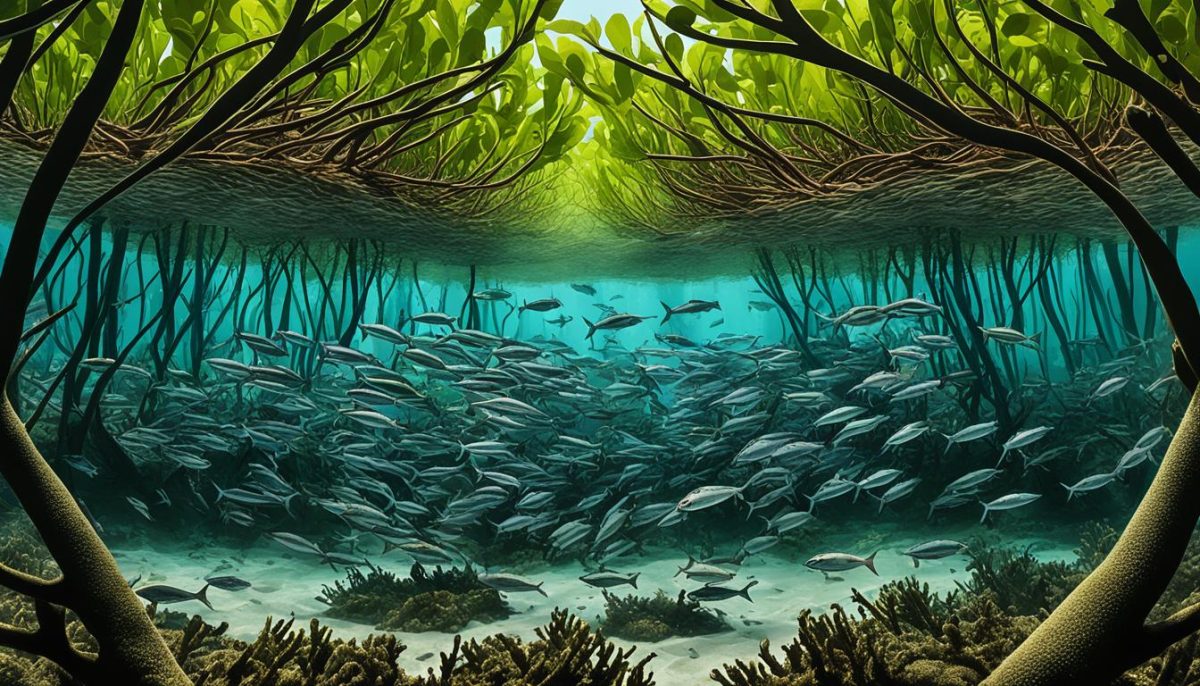Have you ever wondered what mullet eat and how they sustain their nutrition? In this article, we will explore the diverse diet of mullet fish and unveil their fascinating feeding habits. Understanding the food sources that mullet rely on is essential for their conservation and ecosystem balance.
From algae to small invertebrates, mullet have a varied menu that contributes to their growth and energy requirements. Let’s dive into the world of mullet diet, feeding habits, and food sources to gain valuable insights into their nutritional needs.
But first, let’s take a moment to appreciate the beauty of these magnificent fish. Just look at this stunning image of a mullet in its natural habitat:
Understanding Mullet Feeding Behavior
When it comes to the feeding behavior of mullet, there is much to explore. These fascinating fish have distinct food preferences and employ unique foraging techniques to satisfy their nutritional needs. Understanding the mullet’s feeding behavior can provide valuable insights into their ecological significance and aid in their conservation.
Mullet are known for their varied food preferences, which contribute to their ability to thrive in different environments. They feed on a diverse range of food sources, including algae, plankton, small invertebrates, and detritus. Mullet utilize their specialized feeding adaptations to identify and consume these preferred food sources.
One of the foraging techniques employed by mullet is bottom-feeding. They possess a downward-facing mouth that allows them to graze on algae and detritus found on the substrate. By rooting around the bottom of the water bodies, mullet gather food particles to meet their nutritional requirements.
In addition to bottom-feeding, mullet are also skilled filter feeders. They swim with their mouths open, filtering water through their gills as they move. This enables them to capture plankton and other small organisms that are abundant in their aquatic habitats.
“Mullet are fascinating in their ability to adapt their feeding behavior to match the available food sources in their environment.” – Marine Biologist, Dr. Sarah Thompson
Seasonal variations can also influence mullet feeding behavior. During certain times of the year, when food sources are abundant, mullet may exhibit more active feeding patterns. In contrast, during times of scarcity, mullet may need to modify their foraging techniques to locate and secure their preferred food sources.
The knowledge of mullet feeding behavior is crucial for conservation and management efforts. By understanding their food preferences and foraging techniques, scientists can develop strategies to protect and sustain mullet populations, ensuring their crucial role in the ecosystem.
Mullet Feeding Behavior Summary:
- Mullet have diverse food preferences, including algae, plankton, small invertebrates, and detritus.
- They employ various foraging techniques, such as bottom-feeding and filter feeding, to access their preferred food sources.
- Seasonal variations can influence mullet feeding behavior and their ability to find and consume food.
- Understanding mullet feeding behavior is essential for conservation and management efforts.

Common Food Sources for Mullet
When it comes to their diet, mullet have a diverse range of common food sources. These sources provide the necessary nutrients for their growth and energy requirements. Let’s explore some of the key prey that mullet consume:
- Algae: Mullet feed on various types of algae, including filamentous and macroalgae. These plants serve as an important food source for mullet, supplying them with essential vitamins and minerals.
- Plankton: Mullet also rely on plankton, which are microscopic organisms suspended in water. They feed on both phytoplankton (plant-like organisms) and zooplankton (animal-like organisms).
- Small Invertebrates: Mullet have a preference for small invertebrates such as crustaceans and mollusks. These provide a rich source of protein and other necessary nutrients for their diet.
- Detritus: Mullet are known to consume detritus, which refers to decomposing organic matter. They play an important role in the ecosystem by recycling nutrients from decaying plants and animals.
Each of these food sources plays a crucial role in the overall diet of mullet. By consuming a variety of prey, mullet obtain a well-rounded nutrition that supports their growth and survival.

Environmental Factors Affecting Mullet Food Availability
When it comes to the availability of food for mullet, environmental factors play a crucial role. The mullet feeding environment, including water temperature, salinity levels, and other habitat characteristics, significantly impacts the abundance and distribution of their preferred food sources.
Mullet, being highly adaptable fish, rely on specific environmental conditions to thrive. The water temperature, for instance, greatly influences the reproduction and migration patterns of the organisms that form a part of mullet’s diet. With warmer waters, food sources like algae and zooplankton tend to proliferate, providing mullet with a more abundant supply of nutrients.
Similarly, the salinity levels in their habitat can affect the availability of food for mullet. As mullet tend to inhabit estuaries and coastal areas, where freshwater and saltwater mix, they rely on the delicate balance of salinity for their food sources. Any drastic fluctuations in salinity can disrupt the abundance of algae, small invertebrates, and other organisms that form mullet’s diet.
Furthermore, other habitat characteristics, such as water depth, current patterns, and substrate type, also play a key role in determining the availability of food for mullet. These factors can influence the distribution and accessibility of mullet’s preferred food sources, ultimately shaping their feeding patterns and overall health.
Understanding the interplay between mullet feeding environment, mullet food abundance, and mullet habitat is crucial for effective conservation and management strategies. By safeguarding the environmental conditions that support the growth and availability of mullet’s food sources, we can ensure the sustainability of mullet populations and the ecological balance of their habitats.
Implications for Mullet Feeding Patterns
These environmental factors directly impact the distribution and behavior of mullet, influencing their feeding patterns. Mullet tend to exhibit feeding preferences in habitats where their preferred food sources are abundant. This allows them to optimize their foraging efforts and energy expenditure.
For example, during the warmer months when water temperature rises, mullet may migrate to areas where algae and zooplankton are more plentiful. This movement reflects their adaptability and ability to seek out the areas with the most abundant food resources.
Conversely, when environmental conditions change and food availability decreases, mullet may alter their feeding behavior. They may resort to different feeding techniques or adjust their diet to include alternative food sources that are more readily available in their habitat.
Therefore, it is crucial to consider the complex interactions between mullet and their environment when assessing the sustainability of their food sources. By preserving the delicate balance of the mullet feeding environment and ensuring the abundance of their preferred food sources, we can support the health and productivity of mullet populations for generations to come.
Human Interaction and Mullet Diet
Human activities have a significant impact on the diet of mullet fish and their feeding grounds. Various factors such as pollution, overfishing, and habitat degradation can disrupt the availability of food sources for mullet, ultimately affecting their nutrition and overall health.
Pollution in the form of chemical contaminants and excess nutrients in the water can contaminate the mullet’s feeding grounds, leading to changes in the composition and availability of their preferred food sources. This pollution can be a result of industrial waste, agriculture runoff, or improper disposal of waste.
Overfishing poses another threat to mullet’s diet. Excessive fishing can deplete mullet populations, disrupting the natural balance in the ecosystem and reducing the availability of prey organisms that mullet rely on for sustenance. This can have cascading effects on the entire food chain, impacting other fish species and marine life.
Habitat degradation also plays a role in altering mullet feeding grounds. Destruction of essential habitats such as marshes, seagrass beds, and mangrove forests can result in reduced access to shelter, breeding areas, and food sources for mullet. It is crucial to conserve and restore these habitats to ensure the continued availability of food and maintain the health of mullet populations.
Implementing sustainable practices is vital for protecting mullet feeding grounds and promoting their dietary well-being. This includes reducing pollution through proper waste management and water treatment, regulating fishing activities to prevent overfishing, and restoring and protecting essential habitats for mullet and other marine species.
The Impact of Human Activities on Mullet Feeding Grounds:
| Human Activities | Impact |
|---|---|
| Pollution | Contaminates feeding grounds and alters food availability |
| Overfishing | Depletes mullet populations and reduces prey organisms |
| Habitat Degradation | Reduces access to essential food sources and breeding areas |
Conclusion
In conclusion, understanding the mullet diet is crucial for the conservation and ecosystem balance of these remarkable fish. Throughout this article, we explored the diverse diet of mullet, their feeding habits, and their food sources.
The mullet diet summary revealed that these fish have a varied palate, consuming a range of food sources including algae, plankton, small invertebrates, and detritus. Their feeding habits overview showcased their ability to identify and consume their preferred food sources using various foraging techniques.
A recap of mullet food sources emphasized the importance of each food source in the mullet’s overall diet, providing them with the necessary nutrition for growth and energy requirements.
It is essential to consider the environmental factors that affect mullet food availability. Water temperature, salinity, and other habitat characteristics play a significant role in the abundance and distribution of mullet’s preferred food sources. Protecting and conserving mullet feeding grounds is vital to ensure their continued health and well-being.
To maintain a thriving mullet population, it is crucial to address the impact of human activities on their diet. Pollution, overfishing, and habitat degradation disrupt the availability of food sources. Implementing sustainable practices and promoting the conservation of mullet feeding grounds is essential for the long-term preservation of these fish species.
In conclusion, by understanding the mullet diet, feeding habits, and food sources, we can contribute to the sustainable management and conservation of these fascinating fish and maintain the delicate balance of our ecosystems.




